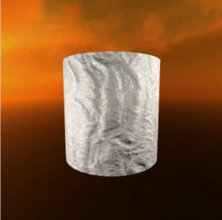Difference between revisions of "HPL3/Materials/Materials Overview"
Jump to navigation
Jump to search
 Tip:
Tip:
| (5 intermediate revisions by the same user not shown) | |||
| Line 1: | Line 1: | ||
| − | |||
{{shortPageTitle}} | {{shortPageTitle}} | ||
| − | + | [[File:Hpl3-material-example.png|thumb|A material viewed in the Material Editor.|222x222px]] | |
A '''material''' is a <code>.mat</code> text file that defines a two-dimensional surface. It contains all of the information needed for HPL3 to simulate the surface visually, aurally, and physically.<br> | A '''material''' is a <code>.mat</code> text file that defines a two-dimensional surface. It contains all of the information needed for HPL3 to simulate the surface visually, aurally, and physically.<br> | ||
The main attributes of a material are: | The main attributes of a material are: | ||
| Line 14: | Line 13: | ||
{{tip|<code>.mat</code> files can be opened directly with the material editor application, if you set it as the default app in your computer's settings.}} | {{tip|<code>.mat</code> files can be opened directly with the material editor application, if you set it as the default app in your computer's settings.}} | ||
| − | ==Example== | + | ==.mat file Example== |
| + | The basic structure of a .mat file is as follows: | ||
<syntaxhighlight lang="xml"> | <syntaxhighlight lang="xml"> | ||
<Material> | <Material> | ||
| Line 57: | Line 57: | ||
</Material> | </Material> | ||
</syntaxhighlight> | </syntaxhighlight> | ||
| + | |||
| + | *<code>Main</code> describe general material parameters. More on that in [[HPL3/Materials/Materials Editor General|Material Editor General]] and in the different material types section in the main Materials category. | ||
| + | *<code>TextureUnits</code> describe different shaders maps the material may use. More on that in [[HPL3/Materials/Texture Units|Texture Units]]. | ||
| + | *<code>SpecificVariables</code> describe further material configuration and unique variables. They vary from different material types. More on that in [[HPL3/Materials/Material Specific Variables|Material Specific Variables]] and in the different material types section in the main Materials category. | ||
| + | * | ||
==Finding Materials== | ==Finding Materials== | ||
<code>.mat</code> files can be found in several locations: | <code>.mat</code> files can be found in several locations: | ||
| + | |||
*Inside a sub-folder under the <code>/textures</code> folder of the game. | *Inside a sub-folder under the <code>/textures</code> folder of the game. | ||
*Inside a sub-folder under the <code>/static_objects</code> folder of the game. | *Inside a sub-folder under the <code>/static_objects</code> folder of the game. | ||
Latest revision as of 08:49, 9 September 2020
A material is a .mat text file that defines a two-dimensional surface. It contains all of the information needed for HPL3 to simulate the surface visually, aurally, and physically.
The main attributes of a material are:
- Material Type
- Corresponding Physics Material
- Texture Units
- Material Variables
HPL3 Material are created and edited using the Material Editor.
.mat files can be opened directly with the material editor application, if you set it as the default app in your computer's settings..mat file Example
The basic structure of a .mat file is as follows:
<Material>
<Main BlendMode="Add" DepthTest="true" ForceFullScaleTextures="true" PhysicsMaterial="Bed" Type="soliddiffuse" UVSubDivs="1 1" UseAlpha="false" />
<TextureUnits>
<Diffuse AnimFrameTime="1" AnimMode="None" AnimStartTime="0" Compress="false" File="textures/detail/algae_detail.dds" MipMaps="true" Type="2D" Wrap="Repeat" />
</TextureUnits>
<SpecificVariables>
<Var Name="HeightMapScale" Value="0.05" />
<Var Name="HeightMapBias" Value="0" />
<Var Name="IlluminationBrightness" Value="1" />
<Var Name="FrenselBias" Value="0.2" />
<Var Name="FrenselPow" Value="8" />
<Var Name="AlphaDissolveFilter" Value="false" />
<Var Name="DissolveLayer" Value="0" />
<Var Name="DetailUvMul" Value="4 4" />
<Var Name="DetailWeight_Diffuse" Value="1" />
<Var Name="DetailWeight_Specular" Value="1" />
<Var Name="DetailWeight_Normal" Value="1" />
<Var Name="DetailFadeStart" Value="5" />
<Var Name="DetailFadeEnd" Value="10" />
<Var Name="SwayActive" Value="false" />
<Var Name="SwayForceFieldAffected" Value="true" />
<Var Name="SwayFreq" Value="1" />
<Var Name="SwayAmplitude" Value="0.1" />
<Var Name="SwaySpeed" Value="1" />
<Var Name="SwayOctaveMuls" Value="0.125 0.25 1" />
<Var Name="SwayForceFieldMul" Value="0.3" />
<Var Name="SwayForceFieldMax" Value="0.6" />
<Var Name="SwayYFreqMul" Value="0" />
<Var Name="SwaySingleDir" Value="false" />
<Var Name="SwaySingleDirVector" Value="0 0 1" />
<Var Name="SwaySingleSampleVector" Value="1 0 0" />
<Var Name="LiquidTrickleColor" Value="0 0 0 1" />
<Var Name="LiquidTrickleSpecular" Value="0 0 0 0" />
<Var Name="LiquidTrickleLoopFade" Value="false" />
<Var Name="LiquidTrickleFadeSpeed" Value="0.5 0.5" />
<Var Name="LiquidTrickleEdgeSize" Value="0.5" />
<Var Name="LiquidTrickleDryness" Value="0.5" />
<Var Name="LiquidTrickleBlendMode" Value="Alpha" />
</SpecificVariables>
</Material>
Maindescribe general material parameters. More on that in Material Editor General and in the different material types section in the main Materials category.TextureUnitsdescribe different shaders maps the material may use. More on that in Texture Units.SpecificVariablesdescribe further material configuration and unique variables. They vary from different material types. More on that in Material Specific Variables and in the different material types section in the main Materials category.
Finding Materials
.mat files can be found in several locations:
- Inside a sub-folder under the
/texturesfolder of the game. - Inside a sub-folder under the
/static_objectsfolder of the game. - Inside a sub folder under the
/entitiesfolder of the game.
